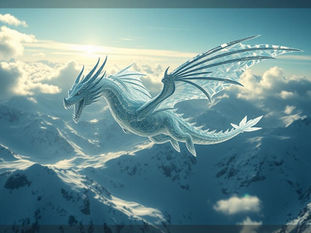
Mastering Midjourney V7: A Beginner's Guide to Prompt Engineering
Apr 21
4 min read
0
4
0

Want to create stunning visuals with Midjourney but tired of blurry potato-like images? This guide breaks down the secrets to crafting effective prompts in Midjourney V7, so you can unlock your imagination and bring your visions to life.
Getting Started with Midjourney Prompting
The Warm-Up: Engaging with the Midjourney Community
Before diving into the technicalities, it's crucial to understand how to interact within the Midjourney community. Don't be a silent observer. Test your ability to chat, ask questions, and engage with others. This interaction is key to learning and growing as a Midjourney artist.
Midjourney as a Binge-Worthy Experience: Neuroplasticity and Your Brain
Have you ever felt addicted to Midjourney? It's not just you. Immersing yourself in Midjourney can actually change your brain through neuroplasticity. This means your brain creates new pathways, making you more attuned to visual and artistic details in the world around you. You might find yourself noticing colors, textures, and shapes in everyday life with a newfound appreciation.
Maybe you're thinking, "How can I speed up my Midjourney process?" That's where automation tools come in handy. They help you refine your creations faster, enhancing your neuroplasticity journey.
Understanding How Midjourney Works
Diffusion and Denoising: The Magic Behind Image Creation
Midjourney uses a process called diffusion to generate images. It starts with random visual noise (a seed) and refines it step-by-step based on your prompt. This process, known as denoising, involves making billions of tiny adjustments to the pixels until the image matches your description.
A seed is like a block of marble, with the potential for an image hidden within. Your prompt acts as the chisel, shaping the noise into a masterpiece.
The Myth of the Seed: Why Consistency is Tricky
While the idea of using the same seed for consistent images is appealing, it's not always reliable. Midjourney assigns jobs to random GPUs, meaning your seed value isn't locked. The seed is most valuable during testing, when you can quickly generate images and potentially hit the same GPU.
The Core Principles of Effective Prompting
Control the Canvas: Avoid Lazy Prompting
The golden rule: If you don't control something in your prompt, Midjourney will fill in the gaps using its best guess. To avoid predictable results, make an effort to control all the details you care about. This means "anchoring" or "pinning" the details to the canvas (the image area).
Optimizing Prompts: Efficiency and Avoiding Incoherence
Each prompt is a timed job on Midjourney's servers. If your request takes too long to process, the AI might start blending and dropping details, leading to incoherence. While V7 is more efficient, it's still important to optimize your prompts. Avoid chaotic tokens, such as conversational instructions in standard prompting mode (use conversational mode for that!).
The Importance of Structure: Grammar, Punctuation, and Clarity
Grammar and punctuation matter because of how tokenization works. A jumbled mess of words will leave Midjourney guessing. Instead, add structure and clarity. For example, instead of "sunset crime eagle city cyberpunk," try "a cyberpunk eagle perched on a rooftop in a neon city glowing at sunset."
Feeling overwhelmed? Try automating your Midjourney prompts. This can help you experiment with different structures and find what works best.
A Practical Framework for Prompt Troubleshooting
Style, Subject, and Background: The Three Pillars of a Successful Prompt
To gain better control over your images, focus on three key elements: style, subject, and background. Think of it as "style depicting subject background." For example, "a flat cartoon depicting an orange sailboat on a teal sea at night."
Style: How should it look aesthetically? (e.g., photorealistic, cartoon, abstract)
Subject: What's in the image? (e.g., a wizard, a spaceship, a cat)
Background: Where is it, and what's the context? (e.g., a forest, a city, in space)
Missing one of these elements can lead to Midjourney filling in the blanks with predictable stereotypes. If you say "a wizard," you'll likely get a Gandalf clone unless you provide more specific details.
Compound Subjects: A Cheat Code for More Visual Storytelling
Use compound subjects to add more elements to your image without exceeding processing time limits. Instead of describing multiple ships, use the word "armada." Instead of listing individuals, use "family," "team," or "committee." This invokes a whole scene with a single token.
Want to take your Midjourney skills to the next level? Check out the Midjourney Automation Suite from TitanXT. Find out more here!
Archetypes: Invoke vs. Describe
An archetype is the dominant representation of something in Midjourney's data set. You can either describe the thing yourself or invoke the archetype and let Midjourney fill in the stereotypical details.
For example, instead of describing a bearded man in a flannel shirt with an axe, you can simply say "a lumberjack." However, be aware that archetypes can be powerful and sometimes undesirable. If you want a cafe scene without coffee, you might need to avoid the word "cafe" altogether and describe the scene in detail.
Using Words Midjourney Understands
Avoiding Chaotic Tokens: Clear, Visual, and Direct Language
Chaotic tokens are words and phrases that Midjourney can't translate into visuals. Avoid jargon, abstract concepts, and conversational instructions in standard prompting mode. Instead, use concrete, visual language. For example, instead of "a sorrowful night longing for home," try "a solitary knight wearing battered armor standing on a foggy battlefield in the dawn light."
Remove conversational language (unless in conversational mode)
Use real sentences with correct punctuation and grammar
Employ dense visual language
Photography Terms: Proceed with Caution
While it's tempting to use photographic metadata like aperture and ISO, these terms often have unreliable effects. Instead, use iconic photographic aesthetics like "Polaroid" or "Leica." You can also source to famous photographers like Ansel Adams or well-known media outlets like National Geographic.
Conclusion: Mastering the Art of Prompting
By understanding how Midjourney works and applying these principles, you can transform your prompts from vague requests into powerful tools for creating stunning visuals. Remember to control the canvas, optimize your prompts, and use language that Midjourney understands. With practice and experimentation, you'll unlock the full potential of Midjourney and bring your imagination to life.






